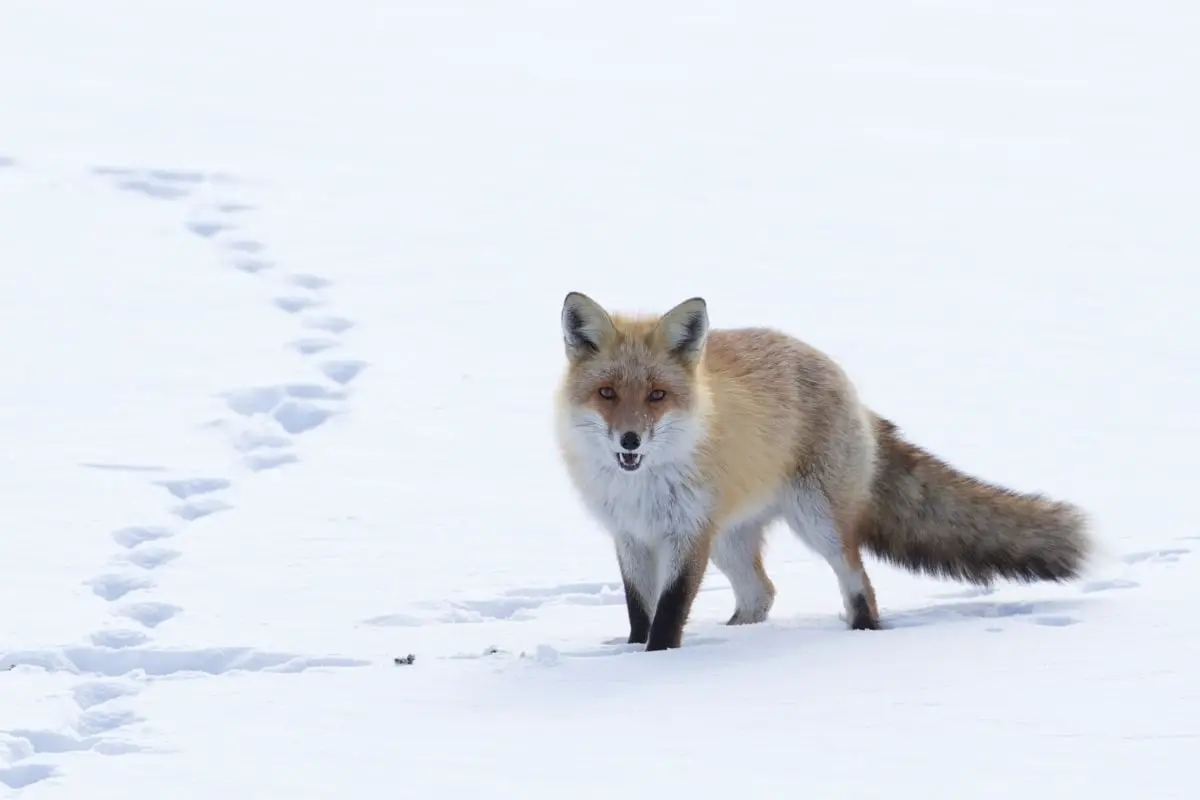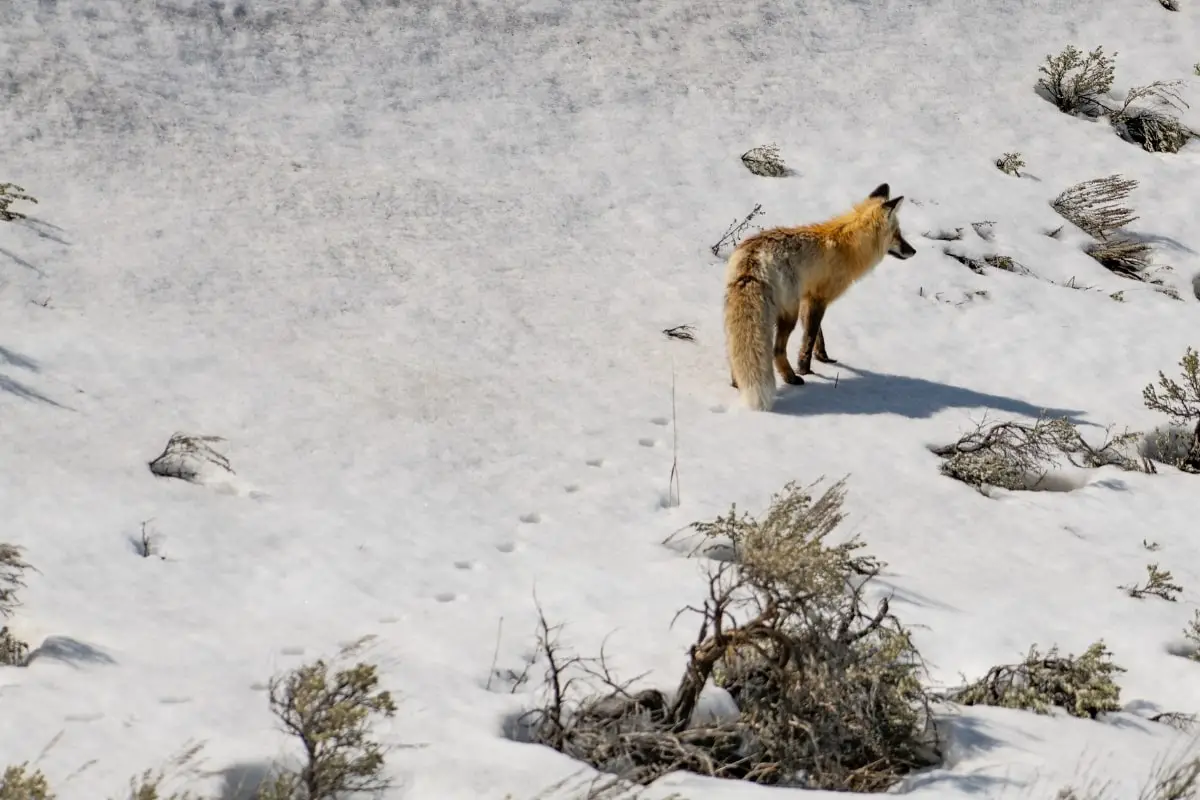Fox tracks can help you identify if there are foxes in your area. Knowing what animals are in an area is an important way to get data about the ecosystem. Let’s take a look at fox footprints and how they are different from other animals.
Fox tracks have 4 digital toe pads and a heel pad called metacarpal pads on the front paws and metatarsal pads on the hind paws. The fox’s claws are sometimes visible in the tracks. The fox track is an oval or diamond shape. The average fox footprint is around 1.5 inches wide and 2 inches long.
Foxes have unique tracks that can make it easier to identify them and rule out other animals with similar footprints. They have a stride of about 12 inches and are usually in a straight light, one foot after the other.
Let’s take a closer look at fox tracks and compare them to other animals such as dogs, cats, and coyotes.
What Do Fox Tracks Look Like?
Fox tracks look different from other animal tracks for several reasons. Foxes have hair on the bottom of their paws, which helps to insulate their paws in the snow and sand. This makes their tracks sometimes appear with hair marks.
Fox footprints have 4 slender toe prints and one large heel pad print. This gives their tracks an oval shape, although some have described them as being diamond-shaped.
Fox tracks have a stride of 12 inches or less and they are in a staggered line. This line is straighter than some canids because the fox has a fast-moving, calculated stride. When the front paw lifts to walk forward, the back paw presses into the front paws track. This is known as perfect walking.
Coyote Tracks Vs Fox Tracks
The biggest difference between coyote tracks and fox tracks is the size. Coyotes are much larger than foxes. They weigh almost double and their prints dig deeper into the ground. Coyote tracks are around 3 inches long, while foxes are only 2-2.5 inches long.
The large heel pad on coyote paws has a center lobe that sticks out, where foxes have a chevron-shaped heel pad. Fox tracks are more petite, they have slender toes, while coyotes have larger toes and footprints.
Fox Tracks Vs Dog
Foxes and dogs are related, so their tracks can be somewhat similar. Dog toes are more fat than fox toes, and they stick out more to the sides. Fox toe prints are skinnier and straighter. Large dogs have much bigger footprints than foxes.
The heel pad on dog paws is much bigger than the fox’s heel pad. A dog’s footprints are more erratic than a fox. They are sometimes zig-zagged, while foxes have a straighter more precise stride and walking pattern. The claw prints of a fox are small while the dog leaves large claw marks.

Fox or Cat Tracks
Since the average fox is around the same size as a large house cat, some may think their prints are similar, but they look very different. Cat footprints are much smaller than foxes. Cat tracks are around 1 inch long, while foxes are around 2 inches.
Cats do not leave any claw marks because they have fully retractable claws. Some foxes such as gray foxes have partially retractable claws that may leave less of a claw mark. Like foxes, cats also have a stride and walking pattern that is in a straight line, one after the other, (perfect walking.)
In most cases, there will be no doubt between a cat footprint and a fox footprint. Even larger cats leave prints that look completely different. Larger cats, such as mountain lions have an m-shaped heel pad and have larger footprints.
Red Fox Tracks
The red fox is the most common in the world. They can be found in many places, with different landscapes, such as forests, fields, grasslands, and even urban areas. A red fox’s footprint is around 2 ½ inches long. This is longer than other foxes.
They share the same slender toes as other foxes and sometimes leave a heavier print, because they are on average, larger than other fox species. Because red foxes live in so many parts of the world, you can find their prints in the dirt, mud, and snow.
Fennec Fox Footprint
The fennec fox is the smallest of all the foxes and possibly the smallest canid in the world. They weigh around 2-3 pounds. These little creatures live in the deserts of Africa and walk mostly on sand. Like other foxes, they also have hair on the bottom of their paws. This helps insulate their feet from the hot desert floor.
These foxes move fast, and since they walk primarily on sandy landscapes their footprints can be somewhat of a mess. Not much is known about fennec foxes in the wild, most of what we know is from data collected by fennec foxes in captivity.
Arctic Fox Paw Print
Arctic foxes are smaller than red foxes. The average red fox is 15-20 pounds, while the average arctic fox is 6-10 pounds. Arctic foxes have short stalky legs. This makes the length of their stride shorter than that of a red fox. They also live primarily in snowy areas, so their prints can be hard to identify. They look more like small round holes in the snow.
Arctic foxes have a lot of fur on the bottom of their feet, this helps them to not freeze in the coldest winter conditions. An arctic fox’s footprint is around 1.5 inches wide and just under 2 inches long.
Gray Fox Tracks
Gray foxes are another fox that is not quite as large as a red fox. They weigh around 8-10 pounds. Their footprints look a lot like red fox’s prints. They have fur on the bottom of the paw which leaves hair marks on the ground.
Because their claws are partially retractable, (they are called tree foxes because their claws allow them to climb trees,) the claws do not always register in their footprint. Gray foxes live in many regions of North America, so you will find their footprints in mud/riverbeds, on forest floors, and anywhere else they call home.
Fox Tracks in Snow
Red foxes and arctic foxes live mostly in the northern hemisphere. This puts some of them in snowy landscapes. A fox print in snow can be hard to define because snow provides many different depths and consistencies. In most cases, they are just round holes punched into the snow.

Red foxes have a larger print, while arctic foxes leave small round holes in the snow. If the surface of the snow is condensed, then you will be able to make out some of the toe prints.
See more about fox habitats.
Conclusion
Now that you know what fox footprints look like, you should be able to identify them. Fox tracks are a good sign that there is a healthy ecosystem in the area where you find them. This means there are food and water sources for them to survive.
If you find fox tracks or signs of fox poop, then chances are you may one day be able to spot foxes in that area. Try not to approach them and admire them from a distance, so as not to disrupt their natural environment.

